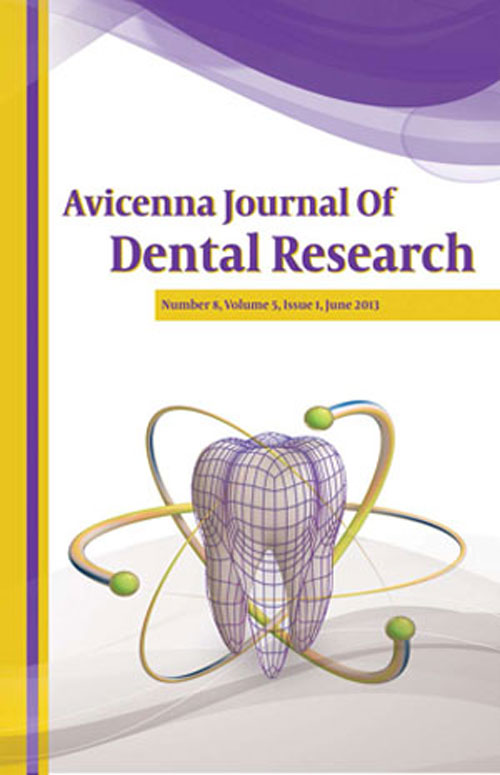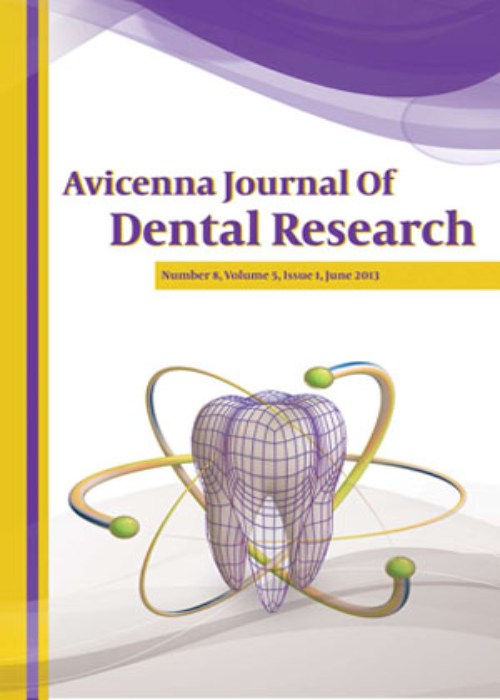فهرست مطالب

Avicenna Journal of Dental Research
Volume:8 Issue: 1, Mar 2016
- تاریخ انتشار: 1394/11/23
- تعداد عناوین: 5
-
-
Page 1BackgroundMany head and neck diseases manifest as neck masses with a wide range of pathologies from developmental lesions to malignancies. However, there is a lack of large-scale studies about the relative prevalence of these lesions in the neck region.ObjectivesThis retrospective study was conducted to assess the distribution of neck masses related to gender, age, pathology, and anatomical location.Patients andMethodsDuring a 13-year period (1996–2009), the medical records of 1,208 patients with neck masses were collected from the department of pathology at Loghman educational hospital in Tehran, Iran. The cases were reviewed for data on gender, age, the type of origin tissue, the type of lesion, and the anatomical location. Comparisons between genders, age groups, and tissue origins were performed using the Chi-square test. The significance level was set at P < 0.05. All statistical tests were performed with SPSS 20 software.ResultsOver a period of 13 years, a total of 1,208 patients (617 men and 591 women) had neck masses resected for pathological assessments. The median age of presentation was 42.1 (ranging from 6 to 83 years). Among the 1,208 cases, 33 cases (2.7%) developed in the pediatric group (≤ 15 years old), 466 cases (38.6 %) developed in the young adult group (16 to 40 years of age), and 709 cases (58.7%) developed in the adult group (≥ 40 years old). Both the inflammatory/infectious and neoplastic lesions were more common in the older adult group with 129 and 433 cases, respectively. The Chi-square test showed significant differences between the genders and the different types of lesions (P = 0.000) and between the different age groups and the different types of lesions (P = 0.000). The anterior triangle (n = 654; 54.1%) was the most common anatomical site for the neck masses, followed by the midline and anterior neck (n = 548; 45.4%), and the posterior triangle (n = 6; 0.5%).ConclusionsThe age and location of neck masses are the most important variables. The data in this study showed that the neoplastic lesions (including metastatic lesions) were the most common neck masses and the anterior triangle was the most common anatomical location. In addition, age can play an important role in differential diagnosis. Therefore, any mass in the neck, especially in older patients, located in the anterior triangle must be considered neoplastic until proven otherwise.Keywords: Prevalence, Neck, Massdifferential Diagnosis
-
Page 2BackgroundBidimensional radiographic methods, including periapical, occlusal, panoramic, and cephalometric radiographs, are widely used in dentistry. However, the superimposition of adjacent structures and consequent loss of anatomic details may occur.ObjectivesThe purpose of this study is to evaluate the artifacts produced by different cements with different densities using cone-beam computed tomography (CBCT).Materials And MethodsSamples of five cements with different densities including glass ionomers (or GI, from ChemFil Rock and Fuji IX), mineral trioxide aggregates (MTA), zinc oxide eugenol (ZOE), TempBond and a control sample (polyester) were scanned by CBCT device and analyzed using OnDemand 3D application software. The amount of artifacts was measured by ∆ gray scale value (∆GSV), which was achieved by subtracting the gray level of the samples from the control group.ResultsAccording to the mean GSV of the five different materials, the majority of artifacts produced were as follows: TempBond > ZOE > MTA > GI (ChemFil Dentsply) > GI (GC, Fuji ΙX).ConclusionsThe type of materials can influence the obtained GSV. Different materials cause various amounts of artifacts due to differences in density and atomic number.Keywords: Artifacts, Cone, Beam Computed Tomography, Dental Cements
-
Page 3BackgroundDentin sensitivity is one of the most important problems in dentistry. Enamel loss due to root exposure is serious issue and common exposure is one of the reasons for dentin hypersensitivity. There are different methods for solving this problem. One of the most conservative and least expensive methods is use of casein phosphopeptide-amorphous calcium phosphate (CPP-ACP) paste.ObjectivesThe aim of this study was to evaluate shear bond strength of GIC to dentin, with or without laser, CPP-ACP paste and polyacrylic acid treatments.Materials And MethodsFifty sound human third molars were bisected in a mesiodistal direction using a diamond disk. Using 400, 600 and 800 grit silicon carbide paper, dentin surfaces were exposed. The teeth were divided into five groups. In groups A, B, D and H, CPP-ACP (GC tooth mousse Itabashi-Ku, Tokyo, Japan) was applied for one hour the first day and repeated at the same time of day for a total of five days. In groups B, C, D and E, the specimens were subjected to laser for 10 seconds using Er, Cr: YSGG laser. In groups B, C, H and G, specimens were treated with 10% polyacrylic acid for 20 seconds. A plastic tube containing GI was positioned over the tooth. Samples were loaded in shear bond using a Universal Testing Machine (Zwick/Roell, Germany), at a 0.5 mm/minute crosshead speed.ResultsDespite the failing of groups A and D, group analysis showed that there were no significant differences between the groups. The predominant type of fracture in all groups was adhesive.ConclusionsApplication of CPP-ACP, without preconditioning with polyacrylic acid, can decrease shear bond strength. Laser irradiation has no effect on shear bond strength of GIC to dentin in this condition.Keywords: CPP, ACP, Laser, Glass Ionomer, Shear Strength, Tooth Mousse
-
Page 4BackgroundThe position of the mental foramen is critical for surgery and local anesthesia.ObjectivesThis study was conducted to assess the position of the mental foramen and its relationship to age in a selected Iranian population.Materials And MethodsThis was a cross-sectional descriptive study. Three hundred panoramic radiographs were assessed. Three variables were assessed for each radiograph: anterior-posterior position, superior-inferior position, and radiographic appearance. The position and appearance of the mental foramen were recorded according to gender and age. The results were analyzed using Chi-square and Fisher’s exact tests.ResultsConsidering the anterior-posterior position, the mental foramina were located in the following positions: between premolars (41.5%), at the apex of the second premolars (31.7%), in the posterior area of the second premolars (19.2%), in the anterior area of the first premolars (4.3%), and at the apex of the first premolars (3.3%).The superior-inferior position of the mental foramina were below, above, and at the level of the apices of the premolars in 78.8%, 2.5%, and 18.7% of cases, respectively. The appearance of the mental foramen was continuous in relation to the mandibular canal in 55.9% of cases, while it was separated, diffuse, and unidentified in 29.5%, 9.7%, and 5% of cases, respectively. Age was found to affect the position and appearance of mental foramen.ConclusionsThe mental foramina were most commonly located between the first and second premolars and below the apex. A continuous appearance was the most common appearance for the mental foramen, which was similar in males and females.Keywords: Mental Foramen, Radiography, Panoramic, Mandible
-
Page 5IntroductionThe glandular odontogenic cyst (GOC) is a rare, locally aggressive and potentially recurrent cyst of jaws which lead in diagnostic and therapeutic challenges. Since 1992, 111 cases of GOC have been reported, with 0.2% incidence among odontogenic cysts.Case PresentationThe patient was a 33-year-old woman who came to the department of oral medicine with a complaint of facial swelling. After taking her history, and conducting clinical, radiological, and histopathologic examinations, the diagnosis of GOC was made.ConclusionsGlandular odontogenic cyst is an uncommon and relatively aggressive cyst with a high recurrence rate. Clinical and radiological evaluations are needed together with careful histopathologic evaluations for diagnosis. Oral medicine specialists should be aware of its characteristic features and make an accurate diagnosis so appropriate management can follow.Keywords: Odontogenic Cysts, Mandible, Case Report


